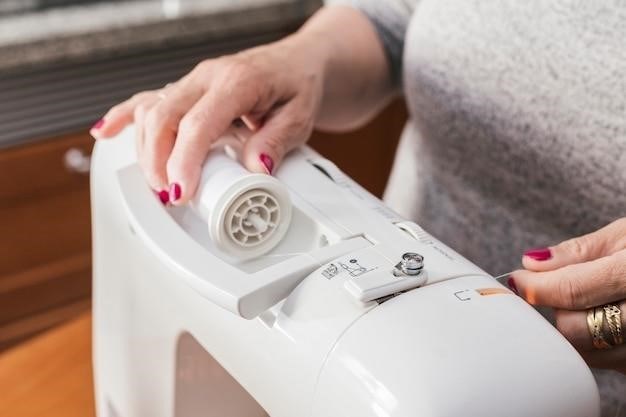Keurig K10 Mini Plus Brewer⁚ A Comprehensive Guide
This guide provides a thorough overview of the Keurig K10 Mini Plus Brewer, covering setup, brewing, cleaning, troubleshooting, and more․ Access the complete owner’s manual online for detailed instructions and warranty information․ Find answers to frequently asked questions and helpful tips for optimal coffee brewing․
Important Safeguards and Safety Precautions
Before using your Keurig K10 Mini Plus Brewer, carefully review these safety precautions․ Never immerse the brewer, cord, or plug in water or other liquids to prevent electric shock and fire hazards․ Always ensure the brewer is placed on a stable, level surface away from heat sources․ Do not operate the brewer outdoors․ Use only the provided power cord; avoid using adapters․ Never leave the brewer unattended while in operation․ Exercise caution when handling the hot water reservoir and brewing components to avoid burns․ Supervise children closely around the brewer․ Regularly inspect the power cord for any damage; discontinue use if damaged․ Unplug the brewer from the outlet before cleaning or performing maintenance․ Always keep the brewer upright to avoid spills and malfunctions․ Consult a qualified electrician if you encounter any electrical issues․ Refer to the complete owner’s manual for detailed safety instructions․
Setting Up and Initial Use of Your K10
Begin by carefully unpacking your Keurig K10 Mini Plus Brewer and inspecting all components for any damage․ Locate a suitable, level surface away from heat sources and water splashes for placement․ Ensure the brewer is unplugged before proceeding․ Fill the cold water reservoir with fresh, filtered water; avoid using distilled or reverse osmosis water for optimal flavor․ The K10 Mini Plus does not have a water reservoir, so it’s crucial to always fill it before each brew cycle․ Plug the brewer into a grounded electrical outlet․ Place a large, heat-resistant mug on the drip tray․ Lift the handle to open the brewing chamber․ The initial use may require a cleansing cycle; refer to the manual for instructions․ After the initial brew, rinse the K-Cup holder and the internal water tank with clean water․ The K10 Mini Plus is ready for brewing once the initial steps are completed․ Now you are ready to enjoy your first cup of coffee!
Brewing Your First Cup⁚ A Step-by-Step Guide
With your Keurig K10 Mini Plus brewer set up and ready, let’s brew your first cup! Ensure the water reservoir is filled with fresh, filtered water․ Place a compatible K-Cup pod into the K-Cup holder; avoid puncturing or removing the foil lid․ Make sure the handle is in the down position to prevent water from entering the lower heating compartment before lowering the handle․ Close the handle firmly․ Place a large, heat-resistant mug on the drip tray․ Do not use a paper cup․ Select your desired brew size (if applicable)․ Press the brew button․ The brewer will begin heating and dispensing water through the K-Cup pod․ Once brewing is complete, the brewer will automatically shut off․ Carefully remove the used K-Cup pod from the K-Cup holder․ Dispose of the used K-Cup properly․ Enjoy your delicious beverage! Remember to always refer to your owner’s manual for specific instructions․ For accurate measuring, do not fill if the Handle is up․ The down position prevents water from entering the lower heating compartment․
Understanding Your K10’s Features and Controls
The Keurig K10 Mini Plus boasts a simple yet efficient design․ The primary control is the brew button, initiating the brewing process once a K-Cup pod is inserted and the handle is closed․ The water reservoir, clearly visible, indicates the water level; ensure sufficient water for your desired brew size․ The K-Cup holder is designed for easy insertion and removal of K-Cups․ The drip tray conveniently catches any spills or excess water․ The power button, typically located on the brewer’s base or side, turns the machine on and off․ A clear visual indicator, such as a light, will typically confirm the brewer’s power status․ The handle mechanism plays a crucial role in the brewing process, ensuring proper water flow through the K-Cup․ The K10 Mini Plus does not include additional features found in higher-end models like programmable settings or multiple cup sizes․ For optimal performance, always use fresh, filtered water and ensure the brewer is properly cleaned and descaled․
Cleaning and Maintenance⁚ Keeping Your Brewer in Top Shape
Regular cleaning is essential for maintaining optimal performance and preventing mineral buildup․ After each use, wipe down the exterior surfaces of the brewer with a damp cloth․ Empty the drip tray and clean it with warm, soapy water․ The K-Cup holder should be rinsed thoroughly to remove any coffee residue․ For more thorough cleaning, periodically remove and wash all removable parts with warm, soapy water․ Avoid using abrasive cleaners or scouring pads, which could damage the brewer’s surfaces․ Once a month (or more frequently if you brew often), rinse the water reservoir with fresh water․ Never immerse the brewer itself in water․ Descaling your Keurig K10 regularly is critical to prevent mineral buildup that can impact performance and coffee taste․ Use Keurig’s recommended descaling solution, following the instructions precisely for optimal results․ Refer to your owner’s manual for detailed descaling instructions and frequency recommendations․
Descaling Your Keurig K10⁚ Removing Buildup for Optimal Performance

Regular descaling is crucial for maintaining your Keurig K10’s performance and ensuring the best possible coffee taste․ Mineral deposits from hard water can clog the internal components, affecting brewing speed and potentially impacting the flavor of your beverages․ The frequency of descaling depends on your water hardness; more frequent descaling may be necessary in areas with hard water․ Always use Keurig-approved descaling solution; never use vinegar or other homemade solutions, as these can damage your machine․ To begin, pour one-third (4․6 oz) of the descaling solution into the cold water reservoir, then fill the reservoir to the 10 oz․ mark with fresh water․ Place a large ceramic mug (never a paper cup) on the drip tray․ Lift the handle, but do not add a K-Cup․ After 5 seconds, lower the handle and press the brew button․ Once the descaling cycle is complete, run several rinse cycles with plain water to remove all traces of the descaling solution․ Consult your Keurig K10 owner’s manual for detailed instructions and specific recommendations for your model․
Troubleshooting Common Issues and Their Solutions
Encountering problems with your Keurig K10? This section provides solutions for common issues․ If the brewer isn’t powering on, check the power cord connection and ensure the outlet is functioning․ A weak brew might indicate insufficient water in the reservoir or a clogged needle; check the water level and clean the needle using a pin or similar tool (refer to your manual for detailed instructions)․ If the brewer is leaking, ensure the K-Cup is correctly inserted and the drip tray is in place․ Slow brewing could be due to mineral buildup requiring descaling․ Refer to your manual’s descaling instructions․ If the brewer shuts off unexpectedly, check for overheating—allow it to cool before restarting․ If you’re experiencing inconsistent brewing temperatures, ensure you are using filtered water as recommended by Keurig․ For persistent issues, consult the complete online manual or contact Keurig customer service for further assistance․ They can provide troubleshooting steps or arrange for repairs if needed․ Remember to always unplug the brewer before performing any maintenance or cleaning․
Water Quality and its Impact on Coffee Taste
The quality of your water significantly impacts the taste of your Keurig K10 brews․ Using unfiltered water can lead to a less flavorful and potentially unpleasant-tasting coffee due to impurities and minerals present in tap water․ These impurities can affect the coffee’s aroma and overall taste profile, leaving a dull or off-putting flavor․ Keurig recommends using filtered water or bottled spring water for the best results․ Filtered water removes chlorine and other sediments that can negatively affect the taste, resulting in a cleaner, more refined cup․ The mineral content also plays a role; hard water, rich in minerals, can leave behind a chalky residue or metallic aftertaste․ Conversely, distilled or reverse osmosis water, while pure, often lacks essential minerals that contribute to the full-bodied flavor of coffee․ Therefore, while you could use these, they may not yield the optimal flavor profile․ Experiment to find what works best for your palate and local water source․ Remember to always check your water reservoir for appropriate water levels before brewing․
Accessing the Keurig K10 Manual Online
Finding your Keurig K10 Mini Plus Brewer manual online is easy and convenient․ Several websites offer free access to downloadable PDF versions of the instruction manual․ A quick search for “Keurig K10 manual PDF” on a search engine will yield numerous results from reliable sources such as the official Keurig website or third-party sites specializing in appliance manuals․ These online manuals typically provide comprehensive instructions on setup, operation, cleaning, troubleshooting, and warranty information․ The digital format allows for easy searching and navigation, making it simple to locate specific information quickly․ Always verify the authenticity of the website before downloading to ensure you’re accessing the correct and most up-to-date version․ If you have difficulty locating the manual online, contacting Keurig customer support directly is another option․ They can assist you in obtaining a copy of the manual or answer any questions you may have regarding your brewer․

Warranty Information and Customer Support
Your Keurig K10 Mini Plus Brewer likely comes with a manufacturer’s warranty․ The specific terms and conditions of this warranty, including duration and coverage, are detailed in the owner’s manual․ Typically, warranties cover manufacturing defects but may exclude damage caused by misuse or neglect․ It’s crucial to retain your proof of purchase receipt as it’s often required to make a claim under the warranty․ Should you encounter any problems with your brewer during the warranty period, promptly contact Keurig customer support․ Their contact information, including phone number and email address, is usually found in the manual or on the official Keurig website․ Keurig customer support representatives can assist with troubleshooting issues, guide you through warranty claims, and provide answers to any questions you may have․ Remember to clearly describe the problem you’re experiencing to facilitate efficient resolution․ In addition to warranty support, Keurig often offers helpful resources such as FAQs and online troubleshooting guides on their website, providing further assistance before contacting support directly․



